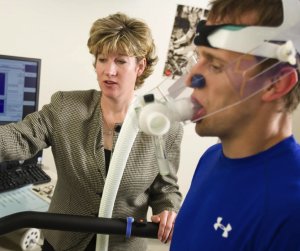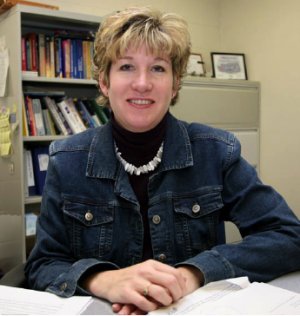Old black and white movies about collegiate life show trim and healthy students, books in hand, strolling on tree-shaded pathways. Today’s images reveal something different—not- so-slim drivers competing for parking places next to their lecture halls.
One University of Nebraska at Kearney researcher is using the university and community as a research model to promote increased physical activity among students. These studies are showing that relatively modest and common sense approaches and ideas can promote increased exercise.
If Kate Heelan, an associate professor in the Department of Health, Physical Education, Recreation and Leisure Studies, has her way, UNK will become—and become known as—“The Wellness Campus.” And her dream may yet turn into reality, given the frenetic pace of her scholarly campaign to obliterate obesity by encouraging—and, yes, even forcing—campus inhabitants to walk.
From her office in the Human Performance Laboratory wing of the Cushing Coliseum at UNK, Dr. Heelan not only teaches and mentors dozens of undergraduate and graduate students, but orchestrates a steady flow of externally-funded programs and research activities, all designed to prevent excessive weight gain, increase physical activity and enhance wellness.
It All Starts With a Plan
How do you get people to move instead of ride or sit? Have a plan, and make it fun and interesting, too.
 For example, hundreds of children in Kearney are now walking to school as a part of a Dr. Heelan-organized “Walking School Bus to Increase Physical Activity,” an innovative and ambitious program funded by the American Heart Association. Here, volunteer UNK students pick up kids like a choo-choo train and walk them to school.
For example, hundreds of children in Kearney are now walking to school as a part of a Dr. Heelan-organized “Walking School Bus to Increase Physical Activity,” an innovative and ambitious program funded by the American Heart Association. Here, volunteer UNK students pick up kids like a choo-choo train and walk them to school.
Hundreds more youngsters participated in the third annual “Nebraska Kids Fitness and Nutrition Day,” also a Dr. Heelan-designed-and-organized event at UNK, this one funded by the Nebraska Beef Council. In September 2006, nearly 600 fourth-graders from Buffalo County came to the UNK campus to join in an event that promoted physical activity and proper nutrition habits.
The day saw these school children, 70 teachers and parents, and 140 UNK volunteers—students, faculty and staff—enjoying 15 “physical activity stations” on Foster (football) Field including an obstacle course, step aerobics, parachutes, fitness balls, “down-the-tubes,” and many more enticing games.
Six nutrition education stations in Cushing Coliseum balanced the strenuous physical exercise on the field. Dr. Heelan and the Nebraska Beef Council also provided funding to five other communities in greater Nebraska to host the same event.
Not Just the Latest TV Fad!
For Dr. Heelan, this is not just following the latest TV-guru-generated exercise and diet fad. Her projects and programs, besides being fun and improving the health and well-being of the participants, are all designed to better understand, through the scientific method, how the body performs, how to motivate participation, and actually why regular exercise, even simple exercise like walking, leads to better health.
“Getting people to understand that physical activity and exercise are different is very difficult,” said Dr. Heelan. “We need to change the mind-set of adults today that exercise should not be a punishment, but should be enjoyed. Getting daily physical activities like going for a walk, gardening, bike riding with children, these physical activities can be very enjoyable, less intimidating and still provide health benefits.”
Dr. Heelan is worried as researchers have stated that the current generation of adults may die before their parents due to the obesity problem which primarily stems from lack of exercise.
Everything in society nowadays, she noted, is built for the automobile, with limited walking access in many places to parks and recreation areas. “The number one predictor of physical activity in children is time outside,” she says. “If kids can’t walk to school or walk to a park because of traffic and infrastructure, they choose sedentary behaviors.”
Campuses, above all places, she says, should embrace concepts of “New Urbanism,” a national movement that calls for a tightly designed and aesthetically beautiful live-work-play community where cars become an afterthought, largely unnecessary.
On campuses, she says, everyone insists on parking next to the building where they take classes, work or teach. “Why not push parking lots further away,” she says. “Why not hide the elevators in buildings, and instead build big, beautiful staircases that are welcoming, places you want to be instead of wanting to avoid.”
Creating the Walking School Bus
Dr. Heelan first became interested in obesity and its relation to wellness while working on her Masters degree with Joseph Donnelly at UNK and then later while working on her Ph.D. at the University of Kansas.
From this interest came the idea that walking to and from school each day, formerly the norm in the United States, could be attainable once again.
She conducted her first study in 2001, evaluating how many children walked to school on a regular basis. From that data, she implemented the Walking School Bus in Kearney, a nationally-noted program in which college students meet children at neighborhood “walk stops” within a one-mile radius of their school and walk the children to school, picking up added children along the route. The college students also walk the children home in the afternoon. After coming to Kearney, she found a perfect opportunity to implement and evaluate the concept over a longer period of time.
The research/physical activity intervention is now entering its fourth year in Kearney, with two elementary schools involved in the program and one elementary school serving as the control group. In the fall and spring of each year, participating children are assessed for height, weight and skin fold measures to determine body composition.
Participants also wear accelerometers, an objective measure of daily physical activity to evaluate the outcome of the study. About 30 UNK students each semester are involved in the study, shepherding students and collecting and managing the data.
The conclusion of the study so far confirms that, according to the title of a recent abstract in Obesity Research, “Frequent walking to and from school over two years does alter body composition in grade school children.”
Dr. Heelan’s research has been published in numerous scientific journals including Medicine and Science in Sports and Exercise, Obesity Research, International Journal of Obesity, Journal of Strength and Conditioning Research, and several others.
She has presented her work at many national scientific meetings including the American College of Sports Medicine National Meeting, the North American Association for the Study of Obesity, The American Alliance for Health, Physical Education, Recreation and Dance National Meeting and many other regional and state-level scientific conferences.
Through UNK’s extensive undergraduate research program, Dr. Heelan also gives students the opportunity to work first-hand on a significant faculty research project.
“I have been able to develop my own specialties through working with Dr. Heelan and her Walking School Bus project,” said Bryce Abbey, one of Dr. Heelan’s former student researchers. “I have presented research at a national conference and met many professionals in the exercise science arena from my work with the project.”
A Change in Perception?
Dr. Heelan’s work is a bright spot in an otherwise dismal future of weight-related health problems. But other lights may be beginning to glisten.
“I hate to be pessimistic, but our society promotes more sedentary activities than physical activities,” Dr. Heelan said. Through the gloom, though, she sees a societal realization, of sorts, that the problem of obesity and wellness in society are linked. She cites the interest of certain large private foundations, such as the Robert Wood Johnson Foundation, which promotes such themes as the concept of “Active Living by Design,” a program that is a part of the New Urban movement.
She also sees hope in the establishment of a “Health Report Card,” an indicator for parents of progress—or lack thereof—in the prevention of overweight in America’s kids.
Besides having developed a profound professional interest in the related topics of wellness and obesity prevention, Dr. Heelan points to her own two young children, ages 3 and 5, as powerful motivators in her crusade. Traditional medical care plots a child’s weight only through age one or two. Dr. Heelan’s program is tracking the height and weight of more than 2,200 elementary children each year.
The parents have more hang-ups than the children about exercise,” she concludes. “They are far too accustomed to getting in a car to go somewhere when walking might be just as easy, and far better. It’s the simple things,” Dr. Heelan says, “that will make a huge benefit.”
